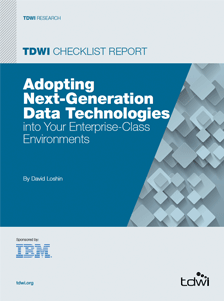
TDWI Checklist Report | Adopting Next-Generation Data Technologies
June 26, 2014
In this Checklist Report we look at some of the opportunities for
embracing new technologies in ways that leverage the existing
enterprise architectures and how to balance incorporating new
techniques (where they add value) with reliance on enterprise-hardened
architectures representing existing corporate investments.
The data management industry is currently abuzz with a growing
variety of non-traditional approaches for enabling reporting, business
intelligence (BI), and different kinds of analytics to meet the needs
of business users hungering for actionable insight. In turn, the desire
to adopt new and innovative technologies is increasingly being driven
by business consumers aching to bypass the information technology
(IT) department’s control of the application infrastructure as well as
accelerate delivery of new services.
The emerging methods pose challenges to balancing technology
choices. Although the traditional choice of relational database
management systems (DBMS) from established vendors has
generally been a sound one, big data techniques present new
alternatives for rapidly delivering insight to the business user.
On the one hand, established technologies can be perceived as
inadequately addressing the rapid development and delivery
needs users have for absorbing and analyzing massive amounts of
structured and unstructured data generated via Web, mobile, cloud,
SaaS, and other sources. On the other hand, new technologies are
perceived as inadequate for supporting long-standing traditional
transactional and analytical workloads.
Tools from new vendors incorporating new big data technologies
(such as Hadoop) for distributed and parallel computing and NoSQL
data management are rapidly being evaluated and brought into
organizations. Hadoop is garnering significant curiosity and some
measure of adoption, fueled by a combination of ease of use, opensource
availability, and exploding venture capital investment. However,
although these technologies offer scalable high performance and
flexibility, today it may be premature to rely on them for enterpriseclass
applications.
At the same time, numerous vendors of traditional platforms are
offering the same or similar new technologies that are more robust
and have more enterprise-ready capabilities than the new technologies
can provide. This Checklist Report offers several important items
to consider for your data management infrastructure, whether your
implementation is on-premises, in the cloud, or a hybrid.